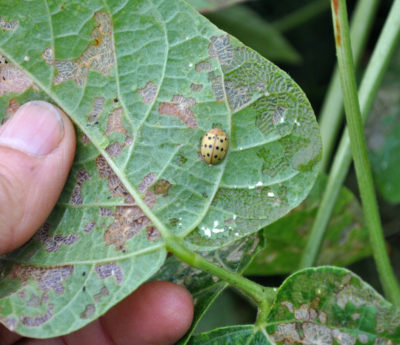A VERY GOOD YEAR, SO FAR
Bye, Bye Beetles
So far, this growing season has been one of the most interesting ever. Could it be global warming? Perhaps. Perhaps it’s all a legacy from the relatively snowless winter with long periods of cold, but not frigid, temperatures. Perhaps it was spring’s two nights of plummeting temperature that followed a warm spell. Perhaps it was this summers extremes of dry and wet periods. Perhaps all that’s from global warming. Perhaps . . .
All I know is that it’s all been pretty good. As I wrote previously, for the second year in a row, Japanese beetles made their entrance on time in June, and then, as if from stage fright, skittered away. Or never emerged from the soil. Or never hatched from eggs laid in the soil. Or the eggs never got laid last summer.
For years, Mexican bean beetles would lay eggs on my bean plants, and those eggs would hatch into voracious larvae and then adults that would shred bean leaves. I was able to harvest enough beans for fresh eating and freezing only with succession planting of bush beans every couple of months.
For the past couple of years, only a few beetles show up here and there; nothing to worry about. So now an early sowing of bush beans provides the first plates of beans, and then passes the torch on to pole beans, which unlike bush beans, keep yielding till the end of the season. Bush beans peter out after a few pickings.
(I did spray neem oil and the biological insecticide ‘Entrust’ a few years ago. Perhaps that broke the Mexican bean beetle cycle here. Perhaps it was the mere threat of a wall at the Mexican border . . . No, no, that can’t be it. Mexican bean beetles have established themselves north of the border for many generations, human and beetle. Throughout the country over many decades, this pest has waxed and waned in its severity, at times turning its taste to soybeans, sometimes to lima beans. My beetles never showed an appetite for my soybeans.)
Two other pests that, I hope, can now be off my radar are scale insects on the greenhouse figs and flea beetles on the eggplants. That status comes with some effort on my part: weekly sprays, until recently, of “summer oil.” I expect to have to maintain those efforts every season. (Late update: I saw a few scale insects on the figs so did have to spray again.)
Skyrocketing Corn, De-Luscious Blueberries
This season’s interests aren’t all about pests.
Right now, corn stalks are as high — no, higher — than an elephant’s eye. (For journalistic accuracy, I looked up the height of an elephant’s eye. One report on the web, that fount of highly accurate information, reported the median height at 98 inches.) I just stepped away from my desk to measure the actual height of my corn, and it topped out at about 10 feet high. And that’s the variety Golden Bantam. I’ve grown it for many years, during which it always topped out at 6 or 7 feet.
The first ears of this rich-tasting, old variety should be ready any day now. Will they also seem to be on steroids?
No explanations for this corny behavior jump out. Year after year, the soil gets the same one-inch depth of compost, the 3-foot-wide corn bed is planted in two rows of hills, thinned to 3 stalks per hill, with each hill 2 feet apart in the row, and the bed is drip irrigated. Mislabeled seed can’t explain the phenomenon because this season’s popcorn (Dutch Buttered and Pearl) and polenta corn (Otto File) also have higher aspirations. Anyway, I’m not complaining.
Apples never grow well here. This low lying valley is a sink for colder, moister air that, along with the backdrop of thousands of acres of forest, is a haven for apple pests. This season, with some spray assistance from me, the apple crop is relatively heavy and attractive. Apples, in those years when I do get a decent crop, are especially tasty here.
I have to tip my hat, once again, to blueberries, my favorite fruit and the most consistent performer among my many fruits. I have never not gotten a good crop of blueberries, come hell or high . . . 17 year cicadas, hurricane Irene, late frosts, etc. This season, canes are arching to the ground with a particularly heavy crop of berries.
What will next year hold? An even better growing season?



Wow! Your corn is skyrocketing! Mine is stumpy this year, but the seedlings were a gift, I didn’t choose the variety. I’m glad your garden is growing well this year 🙂
Hi, Can you elaborate a bit on “summer oil?” It was so hot and dry here in southern Maine that I ended up with multiple pest/disease problems and my young apples were particularly affected. I ended up spraying a copper fungicide which stated a risk for fruit drop and I did lose a few more but the trees seemed to rebound after the treatment. I was reluctant to use neem since they were so far along on fruit development. Is summer oil different than plain horticultural oil or neem? I also found that our Japanese beetles were few and left early. Did more damage to my roses than my fruit this year. And the Golden Delicious apples and Jonagolds were far more resistant to the fungal rust than the Arkansas Blacks, which I ended up stripping from the tree. Next year I will try the clay spray although it is expensive and rarely available in smaller quantities up here.
You need to be clear on what your problems are, and what kind of spray will control them. Oils are generally for insects (although they can control some diseases). “Summer oil” is synonymous with horticultural oil; both are “refined” enough so that they will not damage growing plants. Oils should not be sprayed if the weather soon after is going to be hot, over 80°F. Dormant oils are less refined and used, as the name says, only on dormant plants. Neem oil is from the neem tree and, depending onthe extraction method, also contains other ingredients that may thwart insects and diseases. The clay spray is for insect pests, not diseases.
Your corn and berries look luscious. Back in June I found a Japanese Beetle feasting on my Hollyhock. Plopped it into soapy water and haven’t seen any more. I am so thankful! Due to health problems I didn’t plant much. Better Boys and my Grape Tomatoes are heavy laden. When we had Real Feel Temps of 117 degrees the Better Boys were aborting their fruit and I was afraid none would be left by the time temps stopped soaring. Thankfully I have a nice amount getting ripe daily now. I planted a Brandywine late after I watching a video about planting tomatoes around a 5 gallon bucket and I wanted to experiment. Poor, pathetic and only 3 inches high but one survived and it’s doing fantastic. It has large green tomatoes but not turning yet. Instead of manure and water in the bucket I used my home made compost and water to make compost tea. I look forward to trying it again next year in a more timely matter.
Happy for you! I can practically taste those blueberries. Just read an update on a blueberry muffin recipe by Smitten Kitchen, and if you like muffins, I recommend you consider her method. The corn is of joyful height. It’s fun to read good news once in awhile.